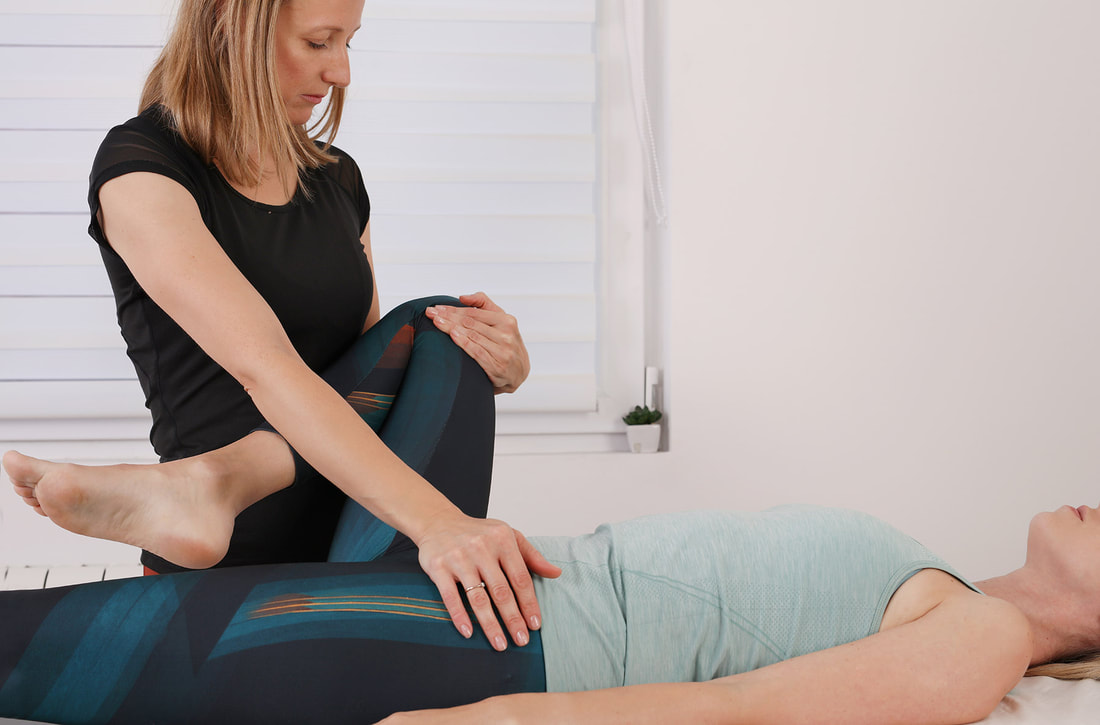​I had a patient tell me that her home health caregivers told her that her hips had nothing to do with her knees. NOTHING could be further from the truth! Your hip strength, Range of Motion and coordination directly impact the health of your knees! If they are not stable and strong, the forces that your hips should absorb and control are directed down to your knees and up to your spine. Yikes! So how might your hips be affecting your knees, and what can we do about it? Continue reading to find out!
As you walk, your hips and feet naturally rotate inward and outward a little bit during different parts of the step cycle. This is good, when it is balanced! Imbalance in your hip muscles can restrict this rotation, or allow excess rotation. In either situation, it can cause twisting or pressure on your knee, which is a common cause of knee pain!
​
You are likely familiar with the gluteus maximus (the big muscles that form the buttocks). This muscle extends the knee (moving the upper leg backwards) and outward rotation. It’s important in stabilizing the hip in rotation, preventing your leg from rotating inward too much. When this muscle is too weak, your leg will rotate inward while you move. This increases stress on the knee, causing a twisting motion on the kneecap and joint due to excessive inward rotation.
​
You are likely familiar with the gluteus maximus (the big muscles that form the buttocks). This muscle extends the knee (moving the upper leg backwards) and outward rotation. It’s important in stabilizing the hip in rotation, preventing your leg from rotating inward too much. When this muscle is too weak, your leg will rotate inward while you move. This increases stress on the knee, causing a twisting motion on the kneecap and joint due to excessive inward rotation.
​The gluteus medius (pictured above) is crucial to stabilizing your hips and pelvis. It functions in abduction of the hip (moving your leg outward) and controlling hip rotation. Weakness in this muscle can significantly impact stability in hips and, as a result, in the knees. When the gluteus maximus weakens, it causes the opposite hip to drop. This applies a valgus force (inward, toward your center of gravity) on your knee joint. Valgus forces on the knee may result in injury of the connective tissue on the inner side of the knee. This pressure can also make it difficult for your patella (kneecap) to track properly. In a person with healthy hips, the kneecap glides smoothly upward and downward as they walk. When you have Patellar Tracking Dysfunction, your kneecap slips somewhat sideways and then gets pulled back into alignment as you walk. Ouch! This irritates the muscles and connective tissue in your knee, especially on the outer side.
A forward lunge can help stretch the hip flexors on the back leg. Only go as far as is comfortable, and be gentle with yourself and your body!
Your hip flexors enable you to lift your upper leg forward. They stabilize your hip rotation, preventing your leg from rotating too far inward. But if they are too tight, they will not allow your leg to rotate far enough inward during the step cycle. As you may have guessed, this forces a twisting motion in your knee, which can hurt! Your hip rotators also help control how much your hip may turn inward or outward. If these are too tight, it doesn’t allow your hip to move as fully as it needs to. Along with causing twisting forces, this can cause patellar tracking dysfunction and damage the connective tissues in your knee. If this continues for a time, it may wear out your meniscus which provides the cushion in your knee that prevents the bones in your legs from hitting one another. Breakdown of that cushion can be very painful.
​
The hamstrings are a group of muscles on the back of the upper leg. They enable you to bend your knee up and back, straighten or extend the hip, and rotate your lower leg while the knee is bent. When your hamstrings are too tight, they pull on the back of your knee and may even make it difficult to straighten your leg. This tension causes a lot of force on the back of your knee, and can cause imbalance and shearing forces between the upper and lower leg. ​
​
The hamstrings are a group of muscles on the back of the upper leg. They enable you to bend your knee up and back, straighten or extend the hip, and rotate your lower leg while the knee is bent. When your hamstrings are too tight, they pull on the back of your knee and may even make it difficult to straighten your leg. This tension causes a lot of force on the back of your knee, and can cause imbalance and shearing forces between the upper and lower leg. ​
Clamshells are a great way to strengthen your hips, especially the gluteus medius and abductors.
​Because the hips are so intimately associated with movement of the knees, it’s important to keep them healthy and strong. This can prevent injury and keep your knees healthy so that you can stay active! Gently stretching and strengthening your hips regularly is a great step toward healthy hips and knees. I like to do clamshells (pictured above) and hip bridges among other exercises to strengthen my hips. To stretch, I like to lay back and fold one leg over the other (pictured below), do a gentle forward lunge, or the butterfly pose (sitting with knees bent and feet together, gently lowering knees toward the ground). A physical therapist can identify hip and knee problems and teach you exercises and stretches specific to your needs. We offer free 25-minute consultations; call (208)237-2080 to schedule yours. Come talk to a PT today, and see how we can help!
This stretch feels great on sore hips and
can increase mobility to prevent excess strain on the knees.
can increase mobility to prevent excess strain on the knees.
|
|





